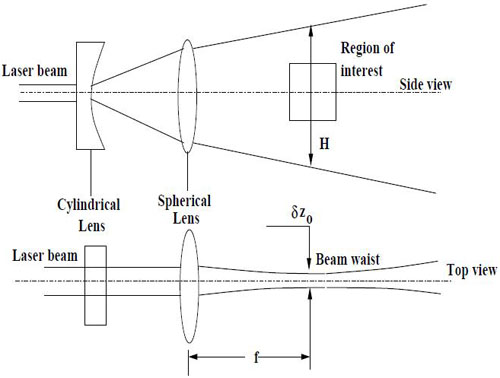Generating a light sheet
For PIV measurement a high intensity light source is required for efficient scattering of light from
tracer particles. Light sheet is generated from a collimating laser beam using cylindrical
lens and spherical lens. The effective intensity of a light sheet can be increased by
sweeping a light beam to form sheet thereby concentrating the energy by a factor equal
to the height of the light sheet divided by the height of the beam. Figure 3.15 shows the
schematic of a light sheet formation. A combination of cylindrical and spherical lens is
used. A negative focal length lens is first used to avoid focal line.The cylindrical lens
causes the laser beam to expand in one direction only, i.e. it "fans" the beam out. The
position of the minimum thickness is determined by the focal length of the cylindrical
lens. The spherical lens causes the expanding beam to focus along the perpendicular
direction,at a distance of one focal length downstream to the beam waist.
Synchronizer
In order to make PIV measurements, different components of the PIV system need to
be time coordinated, for example, the camera, the laser flash lamps and its Q-switches.
The synchronizer controls the time sequence. A part of the functions is executed automatically,
while others have to be defined by the user. The synchronizer thus manages
all the timing events needed for doing PIV measurements.

Fig 3.15: Light sheet formation using spherical and cylindrical lens for PIV.
|